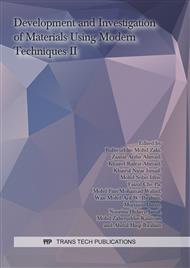p.626
p.632
p.638
p.647
p.653
p.659
p.665
p.672
p.678
Strength and Microstructural Study of Lightweight Aggregate Concrete (LWAC) Using Lightweight Expended Clay Aggregates (LECA)
Abstract:
Concrete is a composite material that consists of a cement and aggregate particles. Microstructure is the small scale structure of a material, defined as the structure of a prepared surface of material as revealed by a microscope. There is strong evidence that aggregate type is a factor in the strength of concrete. The objective of this research is to investigate the properties of concrete that are containing the lightweight expanded clay aggregates (LECA). Digital microscope was used to analyses the formation mechanism of microstructure in concrete. LECA were used in production of lightweight aggregate concrete (LWAC) with the size 50 mm x 50 mm x 50 mm. This paper deals with observation of the concrete microstructure to point out some differences that would be responsible for strength of concrete. The results show that, LECA has several improvements when compared with conventional crushed aggregate. The concrete specimens were used to validate the existence of an interfacial transition zone (ITZ) in concrete. The microstructure features are discussed with respect to their influence on the strength development of concrete.
Info:
Periodical:
Pages:
678-683
Citation:
Online since:
September 2020
Authors:
Price:
Permissions:
Сopyright:
© 2020 Trans Tech Publications Ltd. All Rights Reserved


